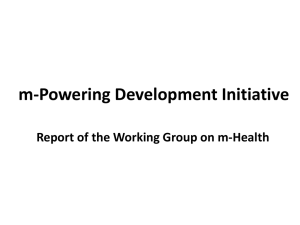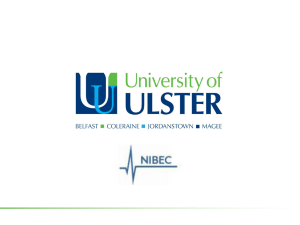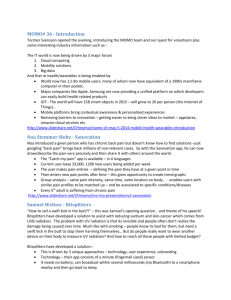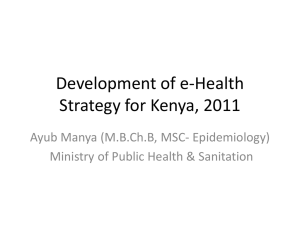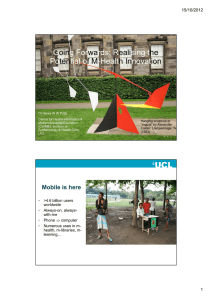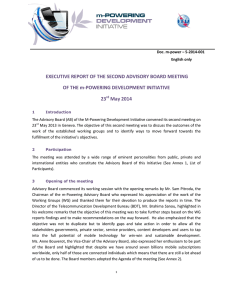Report of the Working Group on m-Health
advertisement
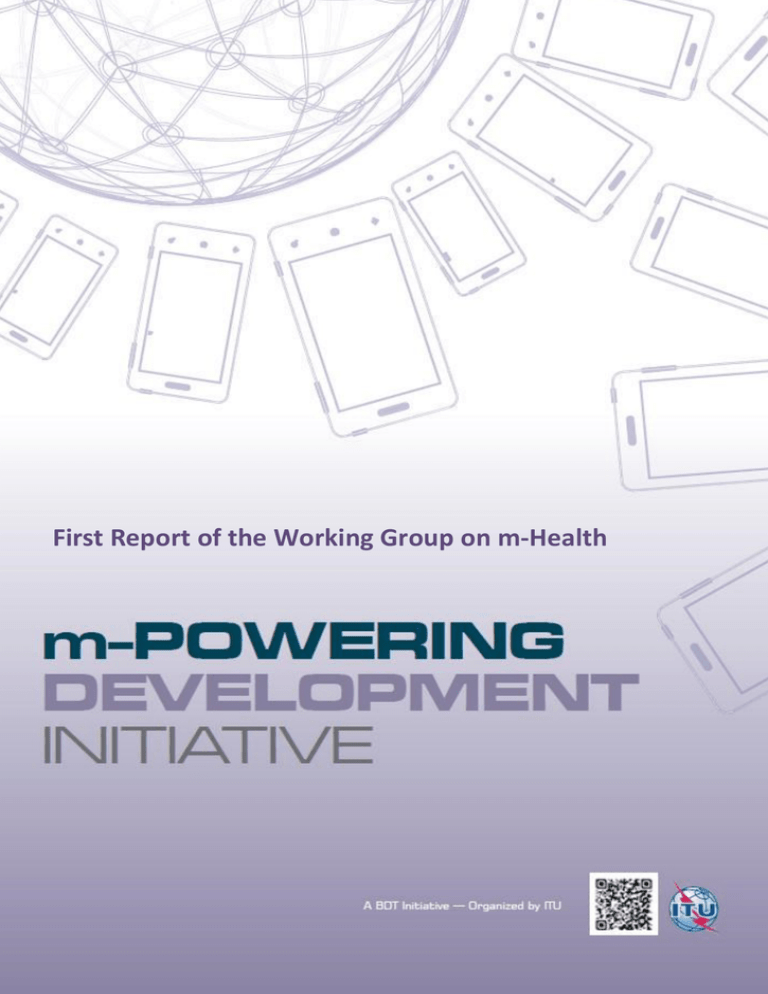
Report of the Working Group on m-Health First Report of the Working Group on m-Health 1 m-Powering Development Initiative Report of the Working Group on m-Health Geneva, 31 March 2014 Executive Summary WHO defines mHealth or mobile-Health as medical and public health practice supported by mobile devices, such as mobile phones, patient monitoring devices, personal digital assistants (PDAs), and other wireless devices. m-Health is considered as a component or subset of e-Health that brings tremendous benefits to patients, healthcare providers, healthcare payers and governments. Real life examples demonstrate that m-Health solutions not only enhance prevention, diagnosis, treatment and monitoring of diseases but they also contribute to strengthen health care systems through improvements in emergency response, healthcare practitioner support, healthcare surveillance and administration. Across the diversity of global health programmes, innovative ways to leverage mobile technologies including wireless communications infrastructure have emerged and been applied in a number of settings. From the most basic application of mobile telephony – that of person to person communication by voice or text - to more sophisticated systems that provide health workers with decision-support tools, scheduling algorithms or point-of-care diagnostics, mobile phones are being seen as an additional tool in the global quest to improve population and individual health, as well as decrease pressure on healthcare systems and associated cost savings. In order to realise the full potential of m-Health and to stimulate scaling up of m-Health services across the globe, important barriers need to be addressed, in particular with respect to policy and regulation. As a guiding principle it is essential to put the individual/person/patient at the centre of the design, development and implementation of solutions, as well as the regulatory frameworks that surround these processes. The m-Powering Development Initiative can play a key role by: Stimulating and facilitating collaboration between Health, Telecoms and Finance Ministries both globally and nationally; Promoting the development of policies, and where appropriate regulation, stimulating innovative business models allowing for funding and reimbursement of m-Health services, by means of identifying and facilitating sharing of good practices/case studies; Supporting initiatives/projects aiming to develop and roll-out m-Health education and training programmes/campaigns for healthcare professionals and patients. 2 Introduction This draft report is a result of collective inputs and reviews by members of the Working Group on mHealth as part of the deliberation of the Board of the m-Powering Development Initiative. Members of the Working Group are listed in Annex I. m-Health is a component or subset of e-Health. To date, no standardized definition of m-Health has been established. WHO defined m-Health or mobile health as: “Medical and public health practice supported by mobile devices, such as mobile phones, patient monitoring devices, personal digital assistants (PDAs), and other wireless devices. m-Health involves the use and capitalization on a mobile phone’s core utility of voice and short messaging service (SMS) as well as more complex functionalities and applications including general packet radio service (GPRS), third and fourth generation mobile telecommunications (3G and 4G systems), global positioning system (GPS), and Bluetooth technology”1. This report focuses on m-Health and is made of the following sections as suggested by the Board, in order to facilitate its integration into the overall report of the Board. 1. 2. 3. 4. 5. 1- Identification of key stakeholders and role of each in support of m-Health Identification of real life examples and best practices that can be replicated and scaled-up Review the current state of play and gap analysis Building sustainable public-private partnerships Recommendations for action to the ITU m-Powering Development Initiative Identification of key stakeholders and role of each in support of m-Health Identification and mapping of stakeholders is an important process in the development of m-Health strategies, plans and projects. Different initiatives require different partnerships to be built, hence understanding which stakeholders are involved and which initiative is in play, enables an assessment of the collaboration opportunities, as well as of the gaps not yet addressed. For m-Health the stakeholders are diverse, coming from different backgrounds and directions. This is simply because e/m-Health is a multidisciplinary domain which by default requires a multi-stakeholder approach. Indeed, there are a number of groups and organisations already driving best practice, developing mHealth pilots and collaboration, providing proof points and stimulating dialogue in the m-Health space between these stakeholders. Examples of these group/organisations include the Continua Health Alliance, Health Information and Management Systems Society (HIMMS), GSMA, and the WHO/ITU working in collaboration. For the purpose of this report, we will attempt to include all stakeholders who have an interest in realizing m-Health objectives today and who may have one tomorrow. Of note is the fact that most of the stakeholders’ categories can belong to the public or the private sector. a. Patients (& Patient Organisations). In people-centred healthcare, the person/patient is the single most important stakeholder. Universal Health Coverage puts the patient in the centre of 1 http://www.who.int/goe/publications/goe_mhealth_web.pdf 3 everything. Improving health and quality of life for patients is the ultimate goal of health systems as it is the patient who requires the medical intervention or who may be searching for information related to health. The rights of the patient have to be respected and services have to meet their needs whilst also being affordable. It is also critical that an environment of trust and safety is created as the acceptance of m-Health interventions is essential for success, this is particularly so in the area of data management and medical device regulation. Patients also require training and education around their health needs/conditions and there is a need for patients to be involved in the development and implementation of m-Health solutions. b. Healthcare professionals. Healthcare is provided through a cadre of professionals and semiprofessionals who have been trained to undertake tasks and functions contributing to better health of people. These include physicians, nurses, laboratory technicians, pharmacists, etc. Each one of these has their own motivations, attitudes, knowledge and skills that drive them to behave in a certain way in healthcare delivery. Respecting their roles and engaging them in the process of mHealth implementation is a prerequisite for success. Another category of cadre that has a major stake in m-Health is the health leaders, managers and administrators. The engagement of these personnel in m-Health initiatives is essential as they manage the healthcare services along with the care providers. Many of the health workers’ categories identified above belong to professional organizations (e.g. nurses’ associations) or companies (e.g. manufacturers of health technologies), many of which belong to the for-profit private sector. Therefore, it is important to understand the motivations of these organizations and companies to facilitate their engagement in m-Health in a manner which benefits people and patients. c. Healthcare payers. This refers to entities other than the patient that finance or reimburse the cost of health services. In most cases, this term refers to insurance carriers, other third-party payers, or health plan sponsors (employers or unions). These need to understand the role of mHealth in cost recovery, reimbursement, and managing other transactions in a secured and a timely manner. d. Telecom operators. The role of telecom operators, as stakeholders, in m-Health is often portrayed as limited to the provision of infrastructure, platforms, connecting of devices and provisioning of services; enabling systems to carry, store and analyse health data and move it from one point to the other. Operators of course do enable connectivity, provide security and authentication and ensure the seamlessness of workflow as an integral part of mobile health services, but what is often forgotten is that operator capabilities exist beyond this limited area. Telecom operators are able to leverage expertise in billing and revenue mechanisms, customer care, device management and distribution networks and so have the ability to be involved in the provision of end to end service management as opposed to being limited to the role of mere connectivity provider. Their engagement and commitment to excellence is a cornerstone in the process. What is vital to the longer term success of m-Health and a prerequisite for operator investment is that services are both scalable and sustainable. 4 e. Regulation authorities. With regard to regulation and m-Health there is an overlap between the Telecom and Healthcare regulatory authorities, and a need for harmonisation of regulation between the two to enable the right environment for m-Health to thrive. i. Telecom regulation authorities. The role of telecom regulators is to protect the interests of consumers by establishing general rules for the public delivery of telecom services, promoting effective and fair competition and facilitating the development of the telecoms market. As a stakeholder in m-Health they − alongside healthcare regulatory authorities − have a responsibility to ensure safety, promote patient and healthcare professional confidence and provide industry with sufficient certainty to innovate and bring new m-Health products and services to the market. ii. Healthcare regulation authorities. Healthcare regulatory authorities at national level (NHR) and those above country level have the role of setting and enforcing standards for healthcare practices and services to make sure that these are compatible with national laws and regulations. m-Health has not been fully integrated in healthcare service delivery which poses a major concern regarding its regulation. NHRs are key stakeholder in m-Health implementation as they set the rules for privacy, ownership and confidentiality of health data as well as funding/reimbursement criteria. While telecommunications regulators set the standard for technical interoperability, NHRs set the interoperability information standards to ensure patient safety and rights. Exchanging patient information using mobile technology requires full engagement by the NHRs to ensure that technology as a carrier and health information as content meet the needs of people. f. Hardware and software vendors. These represent an important element in the m-Health stakeholders group. They provide the tools in the hands of individuals to send and receive data and information such as mobile phones, wearable devices, sensors, applications, etc. Manufacturers and vendors are in control of the design of these tools, their functionality, cost and sustainability. Engaging them in m-Health development as an active stakeholder will ensure they are developing and delivering solutions that meet the needs of people at an affordable cost. It is worth noting here, that achieving this cost objective typically requires scale, and in order to achieve scale solutions should be interoperable and produced using common and accepted standards such as the recently adopted Continua Health Alliance Design Guidelines2. g. m-Health project teams. These are the people who have the vision to bring all partners and stakeholders together to develop and deploy an m-Health solution. They assess the needs, study the feasibility, develop the business plan, allocate the budget, build the team, implement, monitor and evaluate. h. United Nations agencies and other international bodies. The World Health Organization, the International telecommunication Union, UNICEF, UNESCO and UNHCR are only few organizations to mention here. Many others have a role to play as stakeholders in m-Health. These roles are diverse ranging from content development and provision, funding, standardization, monitoring and evaluation, to project management in collaboration with national stakeholders, organizations and 2 http://www.itu.int/net/pressoffice/press_releases/2013/75.aspx#.UzHWDfl_t9w 5 governments. These may include also international standard development organizations that play a major role in standardization and interoperability. i. 2- Others. Content providers who provide health care related content such as health information on the Internet. Educators who provide basic or advance knowledge on m-Health to citizens and other mHealth stakeholders. Funders who provide the financial resources necessary for the development and the implementation of m-Health services. Non-government organizations (NGOs) that work with communities and provide health services at grass-root level. Many of the NGOs understand the needs and work closely with patients not only for provision of care but also for health education and prevention. Communication and mass media workers who provide the necessary visibility to m-Health initiatives, highlighting the value and benefits to individuals and the society. Identification of real life examples and best practices that can be replicated and scaled-up m-Health applications and services can be categorised in different ways. m-Health applications cover a wide range of health services including data collection/disease surveillance, treatment adherence reminders, emergency medical response systems, health information systems and support to healthcare professionals, rural health workers, supply chain management, health financing, disease prevention and health promotion. For the purpose of this report, these applications/services have been put into two main groups: a. Solutions across the patient pathway Prevention – refers to services used by government and non-government agencies to spread awareness and encourage people to adopt or avoid certain behaviours and practices to prevent or control disease. These services and applications aim to leverage the reach of the mobile platform to mobilise communities and promote healthy living. - Prevention services can include: – Regular SMS or voice health information updates – Subscription services to customers who sign up – Games or quizzes played by mobile phone to raise awareness of diseases or health risks (Gamification). – Health information videos distributed by mobile phone – Services to respond to customers’ questions about health Example: Hello Doctor. Launched in South Africa in December 2013, and with an Indonesia launch expected May 2014, the project aims to prevent or mitigate diseases through preventative education and access to affordable medical advice. The advice line offers the general public the opportunity to talk directly to a Doctor for medical information, counselling and advice on first aid, common medical problems, health conditions, risk factors and proper use of medication, 6 Example: m-Cessation (m-Health for Smoking Cessation) The project, launched in Costa Rica in April 2013, aims to prevent smoking-related diseases such as cancer and other lung diseases. Tobacco smoking has been recognized as a big problem in Costa Rica and that many health costs are preventable by getting people to quit smoking. The project includes building and maintaining a database of mobile numbers based on a registration process, create tailor-mad e short messages and develop a two-way communication with smokers. This will entail managing both outgoing and incoming short messages. A mechanism for management of feedback and reporting has been established at the Ministry of Health. Diagnosis – includes services and solutions that help healthcare professionals connect with patients geographically far away to provide diagnosis or triage. - Diagnosis services can include: – Health call centre – Patients video-conferencing with healthcare professionals for a diagnosis – Apps that perform diagnoses – Diagnostic devices that use mobile phones Example: Mobile Baby Launched initially in the United Republic of Tanzania, Nigeria, UAE and Saudi Arabia. From 2012 rolling out across the following countries: Afghanistan, Pakistan, Sri Lanka, Ivory Coast, Benin, Togo, Niger, Central African Republic and Gabon. The project is a complete suite of services enabling birth attendants and midwives to ensure safer pregnancies, labour and delivery in remote areas. It provides ultrasound based remote monitoring of pregnancy evolution, step by step protocol to identify and report danger signs during labour and delivery, money on the phone to pay for emergency transportation and communication with the referral facility indicating emergency transfer and requirements on arrival. Example: Patient images (radiology) on Mobile. India Launched by Jai Prakash Narayan Apex Trauma Centre (JPNATC), New Delhi in 2012. It has made Picture Archiving and Communication Systems (PACS) available on mobile phones for all doctors in the Centre. This enables doctors to view patient radiology in almost real time on their handheld devices over a secure connection greatly improving decision making capabilities. Treatment – includes services that help treat patients remotely and ensure adherence to the required treatment regimen. - Treatment services can include: – Treatment compliance solutions – SMS medication reminders – Smart pill bottles – Smart pills 7 Example: Vitality GlowCaps™ are a cost-effective and scalable solution to increase medication adherence. Randomized clinical studies have demonstrated that Vitality GlowCaps™ can improve adherence from 70% to more than 95%. Example: Cell Phone Applications for Clinical Diagnostic Therapeutic and Public Health Use by Front Line Healthcare Workers, Mozambique. The project principals, researchers from the University of Melbourne, have created a suite of applications that can run on standard mobile phones. The applications provide Mozambican health workers with diagnostic and analytical tools including reference material in the phone’s memory, a calculator for determining drug dosage, and a program for analysing inputs from medical sensors (e.g., low-cost pulse oximeter probes or a simple electrocardiogram). The project ran from March 2008 to March 2009 and concluded with an evaluation of the impact and efficacy of the applications suite. Monitoring – encompasses a broad set of services, applications and devices that help in periodic capture of important health parameters of chronically ill patients or those undergoing post-acute care. It includes monitoring patients to identify and confirm underlying illnesses and monitoring of the vital parameters of at-risk patients to track underlying conditions and take action in order to prevent exacerbation. - Monitoring services can include: – Vital signs monitoring for chronic disease patients – Emergency alarms and independent living solutions for the elderly Example: WellDoc Diabetes Manager. This is an integrated patient coaching and nurse case management system to improve diabetes care. Benefits include: – Proven improvement in A1c levels (1.9%) shown through randomised control trial study vs. a control group, significant even when compared to impact from medication based intervention – Potential to deliver significant financial saving for hospitals. Further clinical studies have demonstrated a 58% reduction in hospital stays – Patients empowered to take greater responsibility for their own care – Ability to track and store patient data for review by healthcare professionals Example: SIMpill and Tellumat, South Africa. A pilot project launched in 2007 showed that with SIMpill, 90% of patients complied with their medication regime, compared to the typical 22 to 60% compliance rate without the system. Reminders to take daily medication using the mobile phone are an effective means to ensure drug regime adherence, which is critical for diseases like TB, where 99% of those infected can be cured with proper medication compliance. The solution is now available worldwide. b. Healthcare systems strengthening Emergency response – Wireless systems enable communication between paramedics in ambulances and physicians in the hospital, plus transmission of patient’s vital parameters whilst en route. 8 Example: Cisco’s Connecting Sichuan Connected Ambulance, China. Enhanced ambulance, connecting major hospital senior doctors with their country counterparts in remote areas in response to natural disasters and emergencies. The benefits include ability to reach disaster-hit areas and provide emergency diagnosis and treatment on site, and to significantly reduce time to treatment for patients. Healthcare practitioner support – Intelligent decision support systems for diagnosis or treatment, Information lookup, Information dissemination. Example: Health eVillages Lwala, Kenya. Variations on the service are also running in China, Haiti and Kijabe in Kenya. The project aims at empowering healthcare professionals in Lwala through new and refurbished mobile phone and handheld devices. Providing the latest in clinical decision support technology and medical references for medical professionals on the ground, enabling provision of improved public health services in poor, remote and previously underserved areas. The benefits include ensuring healthcare professionals have access to up to date medical information and empowering healthcare professionals to make clinical judgements on evidence based clinical information. Example: Map of Medicine for Kijabe Hospital: Remote Data Collection, Kenya. The challenge that was identified is that doctors in Kenya rural areas are often forced to treat individual patients with little or no information about resources in neighbouring areas, impeding them from providing optimum care. The project gives Kenyan health workers at Kijabe Hospital access to the Map of Medicine, a medical information database. The Map of Medicine is a web-based tool that provides comprehensive, up-to-date information on diagnosis and treatment, presented in easy-to-use flowcharts or ‘care pathways.’ Doctors participating in the pilot study were given PDAs and access to data on HIV/AIDS, TB, malaria, abdominal pain, diarrhoea, and typhoid fever. Hospital staff reported that the data access and entry via the PDAs has led to greater efficiency, more time with patients, and reduced administrative costs. Healthcare surveillance – Services and tools that help public health professionals collect healthrelated information about populations and track the outbreak of diseases or epidemics. Example: Chobe Malaria Early Epidemic Detection System (MEEDS), Botswana. Smart phones were provided to health-care workers at 16 facilities in the Chobe District of Northern Botswana which allowed the facilities to submit regular reports back to the Ministry of Health and allow the health workers to report real-time disease outbreak data, tag the data with GPS coordinates and send out SMS disease outbreak alerts to all other healthcare workers in the district. The benefits include testing of suspected malaria cases, which increased from 11% to 98.4% and ability to centrally coordinate treatment and communicate disease outbreak alerts to prevent further spread of disease/infection. 9 Example: Cell-PREVEN-Remote Data Collection. Cell-PREVEN was created in Peru (2009) to allow access to real-time data to members of the healthcare ecosystem in Peru. This interactive voice response system enables health workers in the field to collect and transmit data via basic mobile phones. The data is aggregated in a centralized database and made available to medical professionals, and the system is designed to send SMS or e-mail alerts if certain symptoms are recorded. It was concluded that “cell phones are a feasible means of collecting and reporting data in real-time in remote communities…it’s not necessary to have the latest Palm Pilot or Tablet PC to create a sophisticated public health surveillance system.” Healthcare administration – Services that automate or streamline administrative or back-end processes related to provision of healthcare and positively impact the efficiency of the overall delivery system. Includes services such as appointment reminders. Example: NHSmail SMS Appointment Reminders, United Kingdom. The aim of this SMS messaging programme is to reduce number and impact of patients failing to attend appointments. The benefits are easy to implement with improved outcomes delivered through higher attendance levels, increased healthcare staff productivity and reduced waiting times for appointments, all factors improving access for patients to healthcare professionals. Example: Mobile birth registration in Liberia . The Liberia Poverty Reduction Strategy identifies as one of its priorities the development of a population information system, and particularly, the improvement of birth registration. Universal Birth Registration (UBR) system, the country’s first decentralized electronic birth registration and certification system –launched in 2006 - aims to increase birth registration and certification for children under-six to 90 per cent in two years, which represents an important step towards achieving the fundamental right of every child to a name and nationality at birth. An initiative under UBR promotes the use of mobile-cellular technology to collect birth registration information in rural areas, which is then transmitted via global positioning response signal (GPRS) to the main registration service. This Mobile Birth Registration (MBR) project has been implemented successfully in one county in Liberia and will be scaled up to other counties, allowing the printing of birth certificates in rural counties across the nation. Best practices and replication – Among the challenges facing m-Health is building the knowledge and evidence base of best practices which would allow replication and/or scaling up. The above examples have common elements that could be considered for replication. These include: 1- Public Private Partnerships as the private sector plays a major role in supporting the public sector in implementation of m-Health initiatives; 2- Addressing a healthcare challenge based on deep understanding of the health of the population that the m-Health project is attempting to assist; 10 3- Measurable results which makes monitoring and evaluation possible; 4- Simple services such as SMS that build on the foundations of Electronic Health Records and platforms are a good starting point, which can then over time be expanded into more complex solutions; 5- Engagement of healthcare personnel in all phases of an m-Health solution. 6- Engagement of the patient in conception, design, development, testing and deployment of m-Health solutions. 3- Review the current state of play and gap analysis Across the diversity of global health programmes, innovative ways to leverage mobile technologies including wireless communications infrastructure have emerged and been applied in a number of settings. From the most basic application of mobile telephony – that of person to person communication by voice or text - to more sophisticated systems that provide health workers with decision-support tools, scheduling algorithms or point-of-care diagnostics, mobile phones are being seen as an additional tool in the global quest to improve population and individual health, as well as decrease pressure on healthcare systems and associated cost savings. Whether as a tool able by itself to assist in the delivery of care (as in the case of modern sensor-enabled diagnostic mobile devices) or as a vehicle through which data is exchanged and information is delivered, the ultimate goal of the device/platform/service/data storage and management solution is that the m-Health solution is a catalyst to improve patient outcomes. An m-Health solution usually takes one of three primary approaches towards: a. empowering the client or patient – supporting them with access to information about preventive or curative care, reminders about drug adherence or motivation to change behaviours; b. assisting the provider – helping with workflow management, activity tracking and record-keeping, clinical decision support, or clinical documentation; or c. strengthening the health system – improve supply chain reporting, aggregate performance monitoring, or ensuring quality of service delivery. Increasingly, m-Health strategies maturing into larger implementation or mainstream integration target multiple levels of the system, bridging patient, provider and health system layers. There is widespread recognition across development agencies, national governments, the telecommunications sector, healthcare sector and private industry, of the potential inherent in leveraging ICTs for improvement of public health systems and individual patient outcomes. Despite the proliferation of pilot projects numbering in the hundreds, if not thousands, globally, few mHealth strategies have yet scaled to national or regional deployment and fewer have been adopted as part of global standards of care. Over the past few years, there have been active debate and discourse about the barriers and obstacles that may impede the widespread adoption of m-Health strategies. Initially, it is likely that the novelty of the field, characterized by widespread experimentation and a lack of a shared vocabulary to describe m-Health innovation contributed to some of this confusion. The inclusion of actors new to the discourse of health from the public and private sectors (e.g. Telecommunications national authorities, ministries, regulators, mobile phone and telecommunications companies), brought together two communities/ecosystems each with their 11 own strengths and approaches, this combined with the inherently interdisciplinary nature of mHealth (spanning engineering, health sciences, communication, legislation, education and systems or implementation science) has contributed to the complexity of this emergent ecosystem. Several additional mechanisms have been called for to strengthen the field of m-Health and improve scalability of solutions. First, the importance of leveraging existing evidence-based practices and scientific principles in designing m-Health strategies has been stressed as a universal ‘best practice’. A key shortcoming shared by many early m-Health projects was a concern that implementers were developing solutions in search of problems – a state that has been partially addressed with renewed emphasis by sponsors of m-Health innovation on clear articulation of the underlying health challenge or constraint which is being targeted by the technical solution. Second, a systems approach to m-Health intervention design has been noted by many as critical, to allow incorporation of the up- and down-stream elements which could influence the relative success of a health programme. Engagement of the end user has been noted as important, to ensure that the design of systems integrates functionality and usability as key characteristics of long-term mHealth sustainability. Systems should be grounded in scientific principles, whether behaviourchange theory or tested economic precedent regarding performance-based incentives, etc. In short, the solution will not achieve scale, nor become commercially viable and therefore sustainable, unless end users adopt the solution. Third, with regards to the solid foundation for m-Health innovation, a recognition of the need for an enabling technical, regulatory and commercial environment has emerged. Governments, globally, are formulating national guidelines, standards and regulation to guide m-Health innovation, to prevent the proliferation of non-interoperable, siloed innovation. A lack of coherent strategies because of new grass roots innovations led to disconnected, duplicative innovation that was inherently unscaleable. Where appropriate, common, open-source, or shared architecture has been identified as a possible means to encourage interoperability, while national level policies, regulation (N.B. Regulation can also be at individual country level and above country, e.g. EU regulatory and policy initiatives) and standards governing issues such as common data elements (e.g. unique personal identifiers, facility codes, clinical conditions) allow for data exchange between programmes. These considerations also serve to facilitate integration into existing health systems, allowing for new digital information streams to be merged into national datasets, such as District Health Information Systems (DHIS). It is reassuring to see that empirical evidence supporting the added-value of certain m-Health strategies is increasing rapidly. Certain strategies based on text-message support of drug adherence, or for stock out prevention in low-resource settings, are being scaled-up and mainstreamed. Increasingly, as more rigorous evaluations of these approaches become available and as the impact of m-Health strategies on health system processes or on health outcomes is repeatedly demonstrated, strategies will increasingly move from pilot to deployment at scale. The most challenging unanswered questions seem to remain around the value proposition to health systems and private payers to invest in m-Health – demonstrations at small scale are only beginning to translate into larger implementation at national or regional levels. Providing insight into the financial returns on investment for the public sector (e.g. Improved efficiency and resource allocation, accountability, and population health) or the private sector (e.g. economic benefits, client 12 engagement or customer base expansion, etc.) will be an important priority to address in the future. It should also be acknowledged here that in order for m-Health to reach a level of scale that is sustainable, certainly within established markets, would require fundamental changes in traditional healthcare systems, with changes to patient treatment pathways and a move toward rewarding outcomes rather than just the act of a medical intervention. 4- Building sustainable public-private partnerships Public Private Partnerships (PPP) in m-Health operationalize a commitment by the public and the private sectors to work together for the purpose of designing, planning, financing, constructing and/or operating m-Health projects. Numerous PPPs in health have been in existence for many years. PPPs in m-Health take advantage of a technology developed for other purposes than health, and use it as a crucial vector for healthcare delivery services and other activities. It is not about the private (health) sector funding projects run by the public (health) sector. It is about engaging in a meaningful way across sectors to support a public health cause, because without the public-private development, achieving scale and sustainability is incredibly difficult. It is fair to say that there is not a single m-Health PPPs model that fits all sizes/ countries/ communities. Partnerships are formed depending on the motives of the private sector and the government, the size of the market, the level of penetration of mobile technology, the literacy level of the population, the health needs as well as specific legal and ethical frameworks. The public sector engages in PPPs for a variety of reasons, including greater value for money, sharing or transfer of risk to the private-sector, search for better performance through intervention of private-sector parties, political attractiveness and budgetary constraints. It is important to make sure that none of these reasons or motives becomes the sole reason for building partnerships in mHealth. The private sector engages in PPPs for m-Health initiatives. m-Health PPPs have become a common mechanism for implementation of projects in countries and in communities. Many of these PPPs are concluded with little consideration for the expected benefits to the community and to sustainability, in spite of the general consensus that the interests of people should always be placed in the centre of any PPP. Losing sight of this imperative or drifting the balance to favour the private against the public will most likely compromise the sustainability of the partnership. Further, a point for consideration should be whether the specific technology used for the projects can evolve over time. Indeed, experience has demonstrated that when a pilot project is supported or sponsored by a vendor using a specific proprietary technology, this pilot has no prospect for scaling up and sustainability. Technologies develop very fast and in diversified manner, which makes them short-lived and most often not interoperable. Entering into a partnership with a technology vendor and/or mobile service provider should therefore not be at the expense of another, and public sector partners should insist on operability for any of the technologies used by the PPP. Deploying a technological solution is not the end of a project as sustainability requires maintenance and support all the way including evolution to newer technologies as they become available and cost-effective. As the hardware and 13 software manufacturers and vendors have technological expertise, PPPs would benefit if they could systematically address interoperability and standards issues. In addition to the technology component, a number of considerations need to be considered when assessing the future sustainability and benefit to the people of m-Health PPPs. m-Health PPPs face legal complexities as they often are trans-border and area multinational in many cases. Although mobile companies work under national jurisdictions, they belong to multinational companies. The potential conflicts from a legal point of view between national and international, the private and the public, need thus to be addressed. Like other PPPs, m-Health PPPs require that there be a level of transparency and accountability on all participants. Clarity on objectives and end goals are required, and it is only logical and legal that private sector partners will seek to make a profit, and this needs to be balanced with the need to deliver cost effective solutions for the patient. The objective of an m-Health project may dictate the type of partnership as from the public sector point of view the “content is king”, while from the perspective of hardware and software manufacturers and vendors the technology is the master. This is of course not the case for other private stakeholders, such as health services providers who concentrate on content. Reconciling these two aspects and giving importance to both the content and the technology, while keeping the public interest in mind, is a safeguard for sustainability. As more PPPs and multi-stakeholder partnerships are in operation, reaching a common understanding of shared and distinct objectives between partners may become easier. The lack of clarity on the financial sustainability (which should not necessarily be interpreted as profitability) of m-Health PPPs in low-income countries has so far slowed down private sector investments in this area. For this reason, and although more financial investments into PPPs are crucial for scaling up m-Health, very few large private sector groups have to this date made important investments in the area of m-Health in low-income countries. The telecom and ICT sector have understood the business opportunity perhaps sooner than the private health sector, simply by having witnessed the mobile revolution in their own field of operation. Nevertheless, the relatively modest investment by a few mobile operators into m-Health projects in low- and middle-income countries has not resulted in significant scale up of these projects, nor in the creation of major or core business units around m-Health in these countries. The traditional health private sector became aware only recently of the business opportunity provided by m-Health in low- and middle-income countries. This is exemplified by the fact that only 250 of the existing 97 000 mobile health apps were developed by the pharmaceutical industry3. New developments of such PPPs may follow the participation of a pharmaceutical manufacturers’ association in the ITU-WHO m-Health NCD initiative. The situation is similar for the health insurance sector. An additional constraint to the scaling up of m-Health projects lies in the lack of experience of the health and ICT sectors to work together, in the public and private sectors alike. In governments, ministries of health and of telecommunications are not natural partners, and the pharmaceutical 3 http://research2guidance.com/pharma-companies-far-from-realizing-their-app-market-potential/; http://mobihealthnews.com/20814/report-1-7b-to-download-health-apps-by-2017/ 14 industry or health insurance sector are not traditional partners of telecom operators and internet service providers. These partnerships are therefore complex to put in place, which is an additional challenge and constraint for m-Health scale up. Recommendations for action to the ITU m-Powering Development Initiative: There are many examples (worldwide) of m-Health projects supporting patients, healthcare professionals and healthcare systems, leading to improved patient centred care and outcomes. However, in order to realise the full potential of m-Health and to stimulate scaling up of m-Health services across the globe, important barriers need to be addressed, in particular with respect to policy and regulation. As a guiding principle it is essential to put the patient at the centre of the design, development and implementation of solutions, as well as the regulatory frameworks that surround these processes. The ITU through the m-Powering Development Initiative can play a key role by considering the following recommended actions: 1. Stimulate and facilitate collaboration between Health, Telecoms and Finance Ministries both globally and nationally in order to: a. Build a common understanding and agreement on the role and socio-economic value of mobile technologies and services in addressing current healthcare challenges in the developing world. b. Promote regulatory and policy frameworks enabling the development and implementation of safe, effective, trusted and accessible m-Health solutions – key focus areas: medical device regulation, data protection and privacy regulation (and funding and reimbursement policies and schemes – see below). c. Promoting interoperability and standards that enable scalability and a plug-and-play experience (building on already adopted Continua Health Alliance guidelines). 2. Promote the development of policies, and where appropriate regulation, stimulating innovative business models allowing for funding and reimbursement of m-Health services, by means of identifying and facilitating sharing of good practices/case studies. 3. Support initiatives/projects aiming to develop and roll-out m-Health education and training programmes/campaigns for healthcare professionals and patients. 15 Annex 1 Members of the m-Health Working Group Dr Marie-Paule Kieny (Chair) Mr Housseynou Ba Ms Anne Bouverot Mr Robert Childs Dr Sayave Gnoumou Mr Navin Kapila Dr Veena Rawat Dr Najeeb Al Shorbaji Dr Yuri Grin Ms Florence Gaudry-Perkins Pr. Alain Labrique Dr Mahesh C. Misra 16
